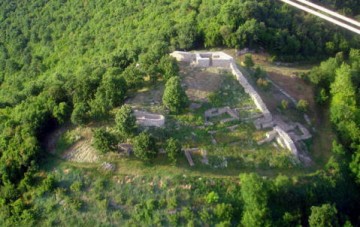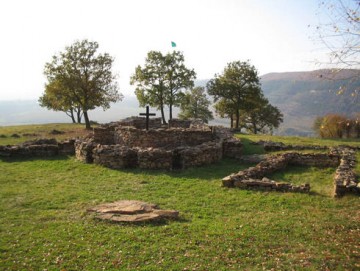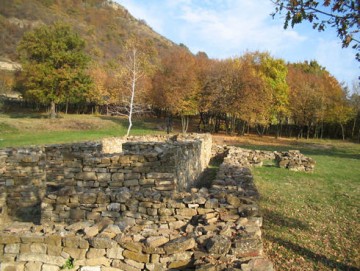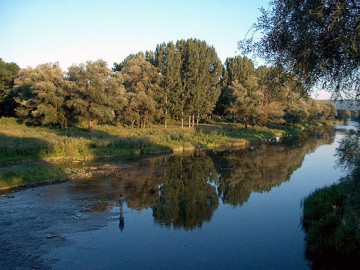Information about the town of Sevlievo
Sevlievo Properties Sevlievo is located in central northern Bulgaria, Gabrovo region. The administrative center of Sevlievo is located near the geographic center of the country, 178 km east of the capital Sofia.The municipality is 1070 sqkm. Settlements are a total of 53, Sevlievo and 52 administrative villages structured in 15 with mayors and 15 villages with deputy mayors. The population of the municipality is about 44,500, of which 27,500 live in the city and 17,000 in the villages.
Sevlievo is located in central northern Bulgaria, Gabrovo region. The administrative center of Sevlievo is located near the geographic center of the country, 178 km east of the capital Sofia.The municipality is 1070 sqkm. Settlements are a total of 53, Sevlievo and 52 administrative villages structured in 15 with mayors and 15 villages with deputy mayors. The population of the municipality is about 44,500, of which 27,500 live in the city and 17,000 in the villages.The altitude of the city is 201 m, but this is the lowest point of the municipality. The ridge of Stara Planina some peaks reaching 1900 meters altitude and hilly terrain with an average height 400-700 meters.The climate is temperate , with a magnitude between the lowest and highest annual temperature - plus 30-35 degrees Celsius in summer to minus 20-25 degrees in winter.The presence of large amounts of high forests in the southern part of the municipality provides significant water resources. Their catchment areas give rise to two major rivers – Rositsa and Vidima, merging close to the city, and their water fill one of the largest artificial lakes in Bulgaria - Alexander Stambolijski Dam Lake.
Natural resources of the municipality are concentrated in three main sectors: timber for industrial and household use; arable land that produces almost all typical for this geographical zone cultures; sources that provide drinking water, water for irrigation and industrial uses.Studies of mineral resources so far have failed.
 The municipality of Sevlievo has comparatively well developed road network. Its density is 0.416 km/sq km and the total length is 391.4 km,divided by class roads. Rail, water and air transport in the municipality does notexists.
The municipality of Sevlievo has comparatively well developed road network. Its density is 0.416 km/sq km and the total length is 391.4 km,divided by class roads. Rail, water and air transport in the municipality does notexists.Tourism
Nature of Sevlievo region presents small scale all natural resources, which is endowed in Bulgaria. The fact that they have no sea is offset by the "little sea" - Dam "Alexander Stambolijski". With its length of 18 km, it provides all opportunities for sailing, boating and water sports, fishing, beach. But this is just a touch on the theme of the rich resources located at a distance of 70 km along the north - south axis and a little more than 40 kilometers of the East - West.
Rolling plain, which begins north of Sevlievo area is part of the Danubian Plain. Here grows the famous Gumza grapes that give one of the best wines of our country. In the village of Kramolin has working winery "Vinenka". Here visitors can taste the young and aged wines and grappa to which there is a wide range of local traditional appetizers.
Rivers Rositsa and Vidima, which merge just above Sevlievo are full of fish: mrena, chub, bream, bleak. Fishing enthusiasts from all over can find here relaxation and pleasant emotions. The high Balkan mountains, that includes part of the National Park "Central Balkan" is a huge biosphere reserve. Flora and fauna give a full picture of the variety of trees, shrubs, grasses, herbs, insects, birds and mammals that may be encountered in the European climate. Some of them are listed in the Red Book of protected species. No exception tourists who like hiking, encountering a herd of wild pigs to see afar deer and why not master of the mountain - the brown bear.
 Sevlievo Mountain also popular as Krushevski hill closes the fruitful Sevlievo area from the north. The highest parts reach 550 meters above the sea level. In the west most part of the River Rosica runs into a beautiful gorge. Here, on the right bank rises a hill, called Kaleto, altitude 486 meters. From this hill is revealed a beautiful view of the whole Sevlievo plain, the Balkans on the south, Vitata stena on the east and the hills to the west. The area is overgrown with oak and hornbeam forests, and low thorny bushes. Vegetation was unable to remove the remains of the stone constructions of mortar solution, mainly fortifications, excavated by treasure hunters. Based on the found coins and ceramics, the site was registered on the list of archaeological sites in the area as early Byzantine and medieval local importance associated with secondary ancient road along the valley of the River Rositsa with deviation from the central roads to the south of Nicopolis ad Instrum.
Sevlievo Mountain also popular as Krushevski hill closes the fruitful Sevlievo area from the north. The highest parts reach 550 meters above the sea level. In the west most part of the River Rosica runs into a beautiful gorge. Here, on the right bank rises a hill, called Kaleto, altitude 486 meters. From this hill is revealed a beautiful view of the whole Sevlievo plain, the Balkans on the south, Vitata stena on the east and the hills to the west. The area is overgrown with oak and hornbeam forests, and low thorny bushes. Vegetation was unable to remove the remains of the stone constructions of mortar solution, mainly fortifications, excavated by treasure hunters. Based on the found coins and ceramics, the site was registered on the list of archaeological sites in the area as early Byzantine and medieval local importance associated with secondary ancient road along the valley of the River Rositsa with deviation from the central roads to the south of Nicopolis ad Instrum.Early Byzantine and medieval fortress Hotalich
The archaeological site is located in the western part of the mountain called Sevlievo. Krushevski hill and is 4 km northwest of the town of Sevlievo. Here river Rositsa leaves the flat Sevlievo plain and runs into a picturesque gorge. After decades of systematic research, visitors can see a kind of open-air museum "Ancient and medieval fortress Hotalich" is one of the best- exposed archaeological sites in Bulgaria. In 1994 it was declared a cultural monument of national importance.
Christian churches of Hotalich
 Until now at Hotalich were found four Christian temples. Two of them are entered into one another and are from different periods. With their disclosure in 1979 began archaeological excavations on the field. Based on the excavated materials, as well as the characteristics of the architectural plans, the older church is known to be dating since V - VI century and the other one later in the XII – XIV century. Today can still be seen preserved pavement inside and stone benches around the walls. Apart from the churches, there were found in the first season of archaeological site two Christian temples - one in the eastern part of the village called Eastern Church and another one on the fortress.
Until now at Hotalich were found four Christian temples. Two of them are entered into one another and are from different periods. With their disclosure in 1979 began archaeological excavations on the field. Based on the excavated materials, as well as the characteristics of the architectural plans, the older church is known to be dating since V - VI century and the other one later in the XII – XIV century. Today can still be seen preserved pavement inside and stone benches around the walls. Apart from the churches, there were found in the first season of archaeological site two Christian temples - one in the eastern part of the village called Eastern Church and another one on the fortress.Citadel
On the difficult to reach hill above the village rise strong walls of the citadel. As a result of decades of excavations are explored and preserved more than 900 m walls in 3m height. It is clear that even in the early Byzantine period IV - VI century hill is surrounded by a strong wall. The existence of Hotalich in Late Antiquity speak significant amount of early Byzantine materials.
The bridge Kolio Ficheto over River Rositsa
Life in the picturesque valley Sevlievska always has been associated with the river Rositsa flowing through it. This proximity to the river besides the numerous advantages over past centuries also led to discomfort when it had to be crossed every time you need to get out of the city to the north and east. When the water level increases, passengers had to wait a few days.
 For chief master of the construction of the bridge was engaged Master Nichola Fichev from Drianovo town, famous Bulgarian builder and architect. The agreement for doing this big project was testing the capabilities of self-taught artist. The bridge he built by Byala later is much more impressive, but it was built with available funds from the central government through a special law of 1864. Sevlievo didn`t have such funds and construction began in 1856. Work went relatively slowly because of lack of money, but in the next year or two the rough construction was completed. The bridge was 110 meters long, it had seven arches, with a central highest one which framed the "hump". In the first half of the twentieth century this hump was flattened, and the bridge was extended considerably by embankments on both sides.
For chief master of the construction of the bridge was engaged Master Nichola Fichev from Drianovo town, famous Bulgarian builder and architect. The agreement for doing this big project was testing the capabilities of self-taught artist. The bridge he built by Byala later is much more impressive, but it was built with available funds from the central government through a special law of 1864. Sevlievo didn`t have such funds and construction began in 1856. Work went relatively slowly because of lack of money, but in the next year or two the rough construction was completed. The bridge was 110 meters long, it had seven arches, with a central highest one which framed the "hump". In the first half of the twentieth century this hump was flattened, and the bridge was extended considerably by embankments on both sides.Batoshevski Monastery
Batoshevski Monastery "Uspenie Bogorodichno" was rebuilt in 1836, with the efforts and resources of Sevlievo Bulgarian community around the site of a medieval monastery from the time of Tsar Michael Asen /1246-1256/. For the construction of the monastery in the thirteenth century stone inscription testifies to the time of Asenevtsi, fragments of which are stored in the collections of the Historical Museum of Sevlievo.
 After the fall of the Second Bulgarian Empire under Ottoman rule Batoshevo monastery the fate of many Bulgarian shrines and it plunged into ruin and desolation. During the next big plague epidemic in the early 30 -ies of the XIX century the families of several Sevlievo leaders escaped in the vicinity of the monastery and promised to rebuild it again.
After the fall of the Second Bulgarian Empire under Ottoman rule Batoshevo monastery the fate of many Bulgarian shrines and it plunged into ruin and desolation. During the next big plague epidemic in the early 30 -ies of the XIX century the families of several Sevlievo leaders escaped in the vicinity of the monastery and promised to rebuild it again.History
Sevlievo occurs as administrative, military, strategic and economic center of the region in the tenth century. Over a naturally fortified place, 3 km northwest of the present town was built a powerful fortress around which large for that time medieval town with infrastructure, with four neighborhoods, two churches, workshops for cutting metal and ceramics. The town existed until the end of the seventeenth century, although the fort was destroyed during the conquest of our lands by the Ottoman Turks in the late fourteenth century. Gradually its business and administrative functions were taken from the present village called earlyer Selvi, Servi, Sevliova. The second half of the eighteenth century Sevlievo is recognized as a center of Turkish administrative district of 50 villages with a strong craftsmanship - tanning, sewing outerwear, metalworking, carpentry. In 1834 the old church was renovated from the seventeenth century with a beautiful carved altar, and in 1846 was built one of the first secular schools in the country, donated by prominent Sevlievo citizen Hadji Stoyan Nikolov.
In the early 70s the city became the center of an organized movement for national liberation - Vasil Levski established the first Revolutionary Committee.  After his capture and hanging his followers make a second committee, which prepares the April Uprising in Sevlievo region. From 1 to 11 May in the mountains kept fighting rebels and the Turkish army - Irregulars and Nizami. Burned and looted four large villages, dozens of neighborhoods, killing more than 300 people - men, women and children.
After his capture and hanging his followers make a second committee, which prepares the April Uprising in Sevlievo region. From 1 to 11 May in the mountains kept fighting rebels and the Turkish army - Irregulars and Nizami. Burned and looted four large villages, dozens of neighborhoods, killing more than 300 people - men, women and children.
 After his capture and hanging his followers make a second committee, which prepares the April Uprising in Sevlievo region. From 1 to 11 May in the mountains kept fighting rebels and the Turkish army - Irregulars and Nizami. Burned and looted four large villages, dozens of neighborhoods, killing more than 300 people - men, women and children.
After his capture and hanging his followers make a second committee, which prepares the April Uprising in Sevlievo region. From 1 to 11 May in the mountains kept fighting rebels and the Turkish army - Irregulars and Nizami. Burned and looted four large villages, dozens of neighborhoods, killing more than 300 people - men, women and children.Eight of the leaders of the uprising were hung at Sevlievo Square. In 1894 on this place grateful companions and descendants built a majestic monument.
Bulgarian community in Renaissance Sevlievo direct its interest in crafts and trade in the first half of the XIX century gradually gained leading positions in them. Workshops Leather - Tabahanans that give food to half the city become the property of Bulgarians and their products already were sold not only in the Ottoman Empire, but in Europe: Vienna, Leipzig, Dubrovnik, Paris and other cities. Hundreds of shops opened doors where from morning till night worked master tailors, blacksmiths, coppersmiths, goldsmiths. They needed to feed a large brood, but to allocate resources for the Bulgarian society.
 In 1834 a renovated old church "St. Prophet Iliya" and in it the best Tryavna masters and painters created the beautiful altar. Two years later, again with the money and the labor of Sevlievo is restored medieval monastery “Uspenie Presvetia Bogorodichno" near village of Batoshevo. But in Renaissance history of the city remains the work of Hadji Stoyan Nikolov - a prominent craftsman and merchant. More than 60,000 coins from his own funds he paid for the construction, furnishing and maintenance of the city's first secular school. In it the first teacher that was appointed was Petko Slaveikov - and by the end of his life the patriarch of Bulgarian literature retains his affection for the people of Sevlievo.
In 1834 a renovated old church "St. Prophet Iliya" and in it the best Tryavna masters and painters created the beautiful altar. Two years later, again with the money and the labor of Sevlievo is restored medieval monastery “Uspenie Presvetia Bogorodichno" near village of Batoshevo. But in Renaissance history of the city remains the work of Hadji Stoyan Nikolov - a prominent craftsman and merchant. More than 60,000 coins from his own funds he paid for the construction, furnishing and maintenance of the city's first secular school. In it the first teacher that was appointed was Petko Slaveikov - and by the end of his life the patriarch of Bulgarian literature retains his affection for the people of Sevlievo.Sevlievo Properties

